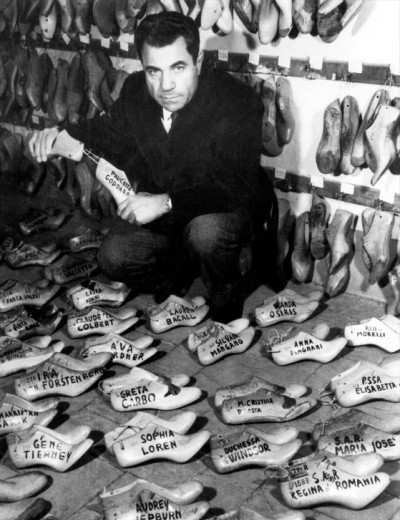Salvatore Ferragamo was born in 1898 in Bonito, near Naples, Italy.. He was one of the most influential footwear designers of the 20th century, providing Hollywood's glitterati with unique hand-made designs and spawning an emporium of luxury consumer goods for men and women, with stores in some of the most important cities of the world.
After making his first pair of shoes at age nine, for her sister to wear on her confirmation, young Salvatore decided that he had found his calling. After studying shoemaking in Naples for a year, Ferragamo opened a small store based in his parent's home.
In 1914, Salvatore emigrated to Boston, where one of his brothers worked in a cowboy boot factory. After a brief stint at the factory, Salvatore convinced his brothers to move to California, first Santa Barbara then Hollywood. It was here that Ferragamo found success, initially opening a shop for repair and made-to-measure shoes, which soon became prized items among celebrities of the day, leading to a long period of designing footwear for the cinema. For more than 30 years he shod the whole galaxy, from Lillian Gish in the first silent films to Marilyn Monroe in the Seven Year Itch. Greta Garbo purchased 70 pairs of shoes in one visit to the shop in Florence. One of his most celebrated pieces are Dorothy's ruby slippers for the 1939 version of The Wizard of Oz.
After spending thirteen years in the United States, Ferragamo returned to Italy in 1927, this time settling in Florence. In 1929 Ferragamo opened a workshop in the Via Manelli, concentrating his efforts in experimenting with design, applying for patents for ornamental and utility models and some related invetions.
Forced to file for bankruptcy in 1933 due to bad management and economic pressures, Ferragamo nonetheless expanded his operation during the 1950 to a workforce of around 700 expert artisans that produced 350 pairs of hand-made shoes a day. By 1936, he was using materials other than leather, such as needlepoint, lace, hemp, cellophane, raffia, cork - he even tried fishskin. Left above is the 1947 "Invisible" shoe made with nylon thread and on the right is the 1938 sandal with gold kid straps and platform sole.
In 1949, he married Wanda Milleti and they had 6 children, Flamma, Giovanna, Ferrucio, Fulvia, Leonardo and Massimo. They followed in their father's footsteps and today the house of Ferragamo is bigger than Salvatore could ever imagine. In 1952 Salvatore got the idea that his heels would last longer if made of steel, and so he fitted some to try out. They were a great success and he called them by the Italian name Stiletto. Ferragamo was always recognized as a visionary, and his designs ranged from the strikingly bizarre objet d'art to the traditionally elegant, often serving as the main inspiration to other footwear designers of his time and beyond.
Salvatore Ferragamo died in 1960 at the age of 62, but his name lives on as an international company, which has expanded its operations to include luxury shoes, bags, eyewear, silk accesories, watches, perfumes and a ready to wear clothing line.
Today, his two sons, James and Salvatore, run the Ferragamo company. The Salvatore Ferragamo Museum was opened in 1995 at the second floor of the Palazzo Spini Feroni in Florence, Italy, to display part of the collection of revolutionary designs by Ferragamo.
Leonardo was only 7 when his father died but when he was 14 he made a pair of shoes for his mother by hand.
the label
The Ferragamo house is a family concern. Mother Wanda keeps an overall eye on everything. The three sons of Salvatore all take care of different activities. Massimo, the youngest looks after the United States from New York. Leonardo Ferragamo, from the Italian headquarters, has moved the overall concern also into fashion design, and supplies exquisite garments world-wide. Ferragamo is also known for printed scarves, soft cashmere shawls and elegant jewellery. They are now a million dollar concern. Leonardo Ferragamo continues to design, as also his sister Fiamma. Giovanna presides over the ready-to-wear production in Milan, Fulvia looks after silk accessories and has also recently added jewellery. They have broadened their product line to include ready-to-wear clothing that is simple but luxurious and also soft leather garments. Mens wear is another line. Salvatore's grand-daughter Vivia (daughter ofFerrucio Ferragamo CEO of Ferragamo, Italy) set up her own London-based label in September 2002 for womenswear. She presented her first catwalk show during the London Fashion Week of February 2003. She has a very feminine, young, fresh look and hopes to be successful. She had spent 3 years learning about design at Emanuel Ungaro which she says was a very positive experience. Marc Audibet joined the Ferragamo Italy design team for the company in 2000. He left after presenting collections for 4 seasons. Nicole Fischelis, former fashion director of Saks Fifth Avenue store in New York, is also part of the design team. In April 2002, Scottish designer Graeme Black joined Ferragamo as chief designer. He was earlier with Armani for many years.
